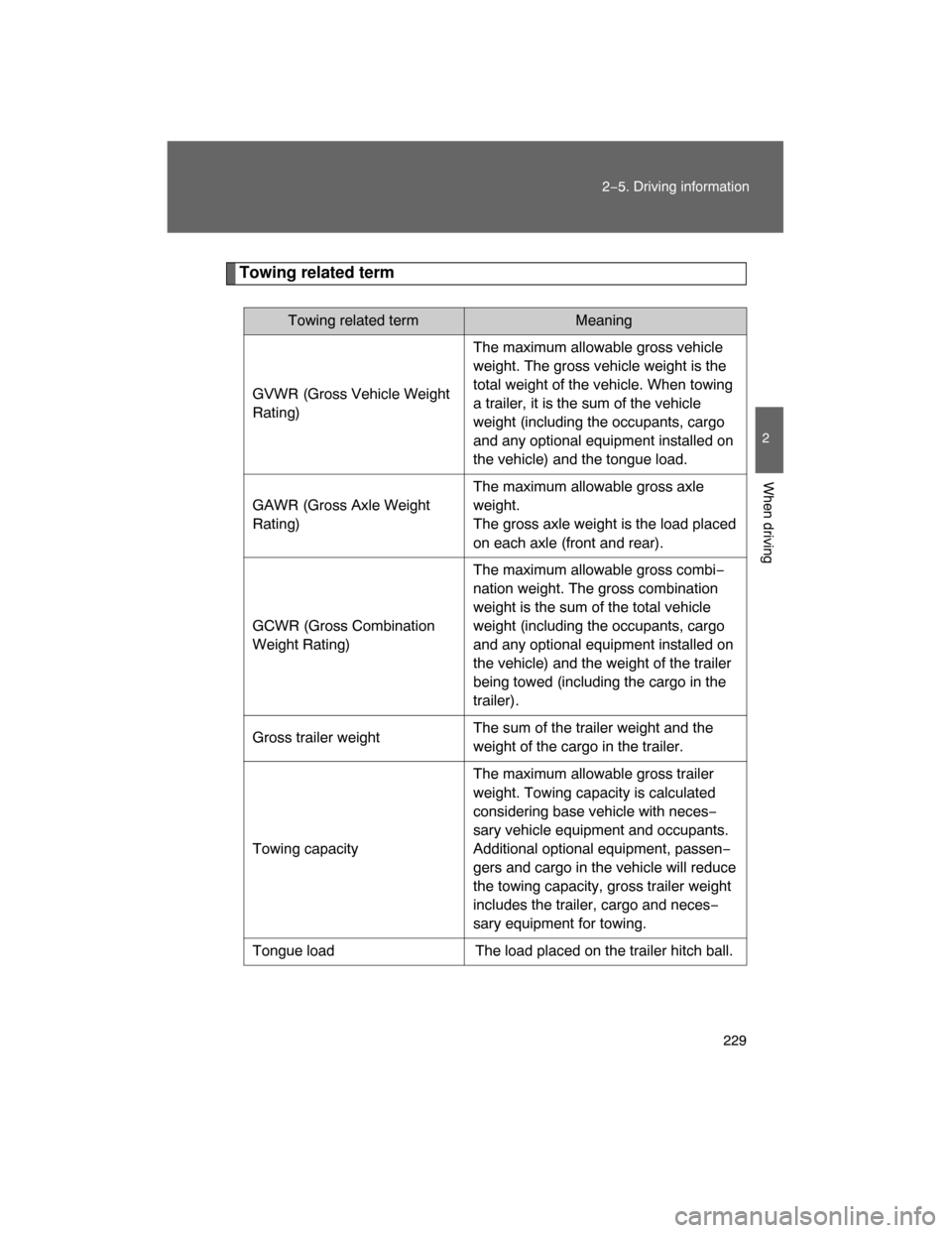Page 227 of 531

229
2−5. Driving information
2
When driving
Towing related term
Towing related term Meaning
GVWR (Gross Vehicle Weight
Rating)The maximum allowable gross vehicle
weight. The gross vehicle weight is the
total weight of the vehicle. When towing
a trailer, it is the sum of the vehicle
weight (including the occupants, cargo
and any optional equipment installed on
the vehicle) and the tongue load.
GAWR (Gross Axle Weight
Rating)The maximum allowable gross axle
weight.
The gross axle weight is the load placed
on each axle (front and rear).
GCWR (Gross Combination
Weight Rating)The maximum allowable gross combi−
nation weight. The gross combination
weight is the sum of the total vehicle
weight (including the occupants, cargo
and any optional equipment installed on
the vehicle) and the weight of the trailer
being towed (including the cargo in the
trailer).
Gross trailer weightThe sum of the trailer weight and the
weight of the cargo in the trailer.
Towing capacityThe maximum allowable gross trailer
weight. Towing capacity is calculated
considering base vehicle with neces−
sary vehicle equipment and occupants.
Additional optional equipment, passen−
gers and cargo in the vehicle will reduce
the towing capacity, gross trailer weight
includes the trailer, cargo and neces−
sary equipment for towing.
Tongue load The load placed on the trailer hitch ball.
Page 228 of 531
230 2−5. Driving information
Trailer tongue load
lA recommended tongue load varies in accordance with the types
of trailers or towing as described below.
lIn order to ensure the recommended values shown below, the
trailer must be loaded by referring to the following instructions.
The trailer cargo load should be distributed so that the tongue load
is 9 to 11 %.
(Tongue load / Gross trailer weight 100 = 9 to 11 %)
If the gross trailer weight is over 5000 lb. (2268 kg), it is necessary
to use a sway control device with sufficient capacity.
The gross trailer weight and tongue l oad can be measured with plat−
form scales found at a highway we
ighing station, building supply
company, trucking company, junk yard, etc.
Gross trailer weight
Tongue load
Page 230 of 531
232 2−5. Driving information
Selecting trailer ball
Use the correct trailer ball for your application.
Trailer ball load rating
Matches or exceeds the gross
trailer weight rating of the trailer.
Ball diameter
Matches the size of the trailer
coupler. Most couplers are
stamped with the required trailer
ball size.
Shank length
Protrudes beyond the bottom of
the lock washer and nut at least 2
threads.
Shank diameter
Matches the ball mount hole
diameter size.
Connecting trailer lights
Use the wire harness stored in
the rear end under body.
ITY25C009
Page 235 of 531

237
2−5. Driving information
2
When driving
CAUTION
nTrailer towing precautions
lFollow all the instructions described in this section. Failure to do so could
cause an accident resulting in death or serious injury.
lExceeding the towing capacity, GVWR, GCWR and GAWR can cause an
accident resulting in death or serious personal injuries.
nTo avoid accident or injury
lDo not exceed 45 mph (72 km/h) or the posted towing speed limit, which−
ever is lower. As instability (swaying) of the towing vehicle−trailer combina−
tion increases as speed increases, exceeding 45 mph (72 km/h) may
cause loss of control.
lSlow down and downshift before descending steep or long downhill
grades. Do not make sudden downshifts.
lAvoid holding the brake pedal down too long or applying the brakes too
frequently. This could cause the brakes to overheat and result in reduced
braking efficiency.
lDo not exceed the trailer hitch assembly weight, gross vehicle weight,
gross axle weight and trailer tongue load capacities.
lNever load more weight in the back than in the front of the trailer. About
60% of the load should be in the front half of the trailer, and the remaining
40% in the rear.
l
Do not use cruise control when you are towing.
Page 236 of 531

238 2−5. Driving information
CAUTION
nHitches
lLubricate the hitch ball with a light coat of grease.
lIf using a weight distributing hitch when towing, keep your vehicle level
with the ground.
nWhen towing a trailer
lIf the gross trailer weight exceeds 1000 lb. (453 kg), trailer brakes are
required. Toyota recommends trailers with brakes that conform to all appli−
cable federal and state/provincial regulations.
lNever tap into your vehicle’s hydraulic system, as this will lower the vehi−
cle’s braking effectiveness.
lNever tow a trailer without using a safety chain securely attached to both
the trailer and the vehicle. If damage occurs to the coupling unit or hitch
ball, there is danger of the trailer wandering into another lane.
NOTICE
nWhen installing a trailer hitch
lUse only the position recommended by your Toyota dealer. Do not install
the trailer hitch on the bumper; this may cause body damage.
lDo not use axle−mounted hitches, as they can cause damage to the axle
housing, wheel bearings, wheels or tires.
nSafety chain
A safety chain must always be used between the towing vehicle and the
trailer. Leave sufficient slack in the chain for turns. The chain should cross
under the trailer tongue to prevent the tongue from dropping to the ground in
the case that it becomes damaged or separated. For the correct safety chain
installation procedure, ask your Toyota dealer.
nDo not directly splice trailer lights
Directly splicing trailer lights may damage your vehicle’s electrical system
and cause a malfunction.
Page 343 of 531
347 3−6. Other interior features
3
Interior features
nThe seat heaters can be used when
The “ENGINE START STOP” switch is in IGNITION ON mode.
CAUTION
nBurns
lUse caution when seating the following persons in a seat with the seat
heater on to avoid the possibility of burns:
�Babies, small children, the elderly, the sick and the disabled
�Persons with sensitive skin
�Persons who are fatigued
�Persons who have taken alcohol or drugs that induce sleep (sleeping
drugs, cold remedies, etc.)
lDo not cover the seat with anything when using the seat heater.
Using the seat heater with a blanket or cushion increases the temperature
of the seat and may lead to overheating.
NOTICE
nTo prevent seat heater damage
Do not put unevenly weighted objects on the seat and do not stick sharp
objects (needles, nails, etc.) into the seat.
n
To prevent battery discharge
Turn the switches off when the engine is not running.
Page 388 of 531

393
4−3. Do−it−yourself maintenance
4
Maintenance and care
Initializing the tire pressure warning system
nThe tire pressure warning system must be initialized in the fol�
lowing circumstances:
lWhen rotating the tires on vehicles differing with front and rear
tire inflation pressures.
lWhen changing the tire inflation pressure by changing traveling
speed or load weight, etc.
lWhen changing the tire size.
When the tire pressure warning system is initialized, the current
tire inflation pressure is set as the pressure benchmark.
n
How to initialize the tire pressure warning system
Park the vehicle in safe place and turn the “ENGINE START
STOP” switch to OFF mode.
While the vehicle is moving, initialization is not performed.
Adjust the tire inflation pressure to the specified cold tire infla−
tion pressure level. (
P. 502)
Make sure to adjust the tire pressure to the specified cold tire
inflation pressure level. The ti
re pressure warning system will
operate based on this pressure level.
Turn the “ENGINE START STOP” switch to IGNITION ON
mode.
STEP1
STEP 2
STEP 3
Page 391 of 531

396 4−3. Do−it−yourself maintenance
nMaximum load of tire
Check that the maximum load of the re
placed tire is greater than 1/2 of
the Gross Axle Weight Ratings (GAWR) of either the front axle or the
rear axle, whichever is greater.
As for the maximum load of the tire, see the load limit at maximum cold
tire inflation pressure mentioned on the sidewall of the tire, and as for the
Gross Axle Weight Ratings (GAWR)
, see the Certification Label. ( P.
401, 507).
nTire types
1 Summer tires
Summer tires are high−speed performance tires best suited to highway
driving under dry conditions. Sinc
e summer tires do not have the same
traction performance as snow tire s, summer tires are inadequate for
driving on snow−covered or icy roads. For driving on snow−covered
roads or icy roads, the use of
snow tires is recommended. When
installing snow tires, be sure to replace all four tires.
2 All season tires
All season tires are designed to prov ide better traction in snow and to
be adequate for driving in most winter conditions, as well as for use
year round. All season tires, however, do not have adequate traction
performance compared with snow tires in heavy or loose snow. Also,
all season tires fall short in acceleration and handling performance
compared with summer tires in highway driving.
3Snow tires
For driving on snow−covered roads or icy roads, we recommend using
snow tires. If you need snow tires,
select tires of the same size, con−
struction and load capacity as the or iginally installed tires. Since your
vehicle has radial tires as original equipment, make sure your snow
tires also have radial construction. Do not install studded tires without
first checking local regulations for possible restriction. Snow tires
should be installed on all wheels. (
P. 222)